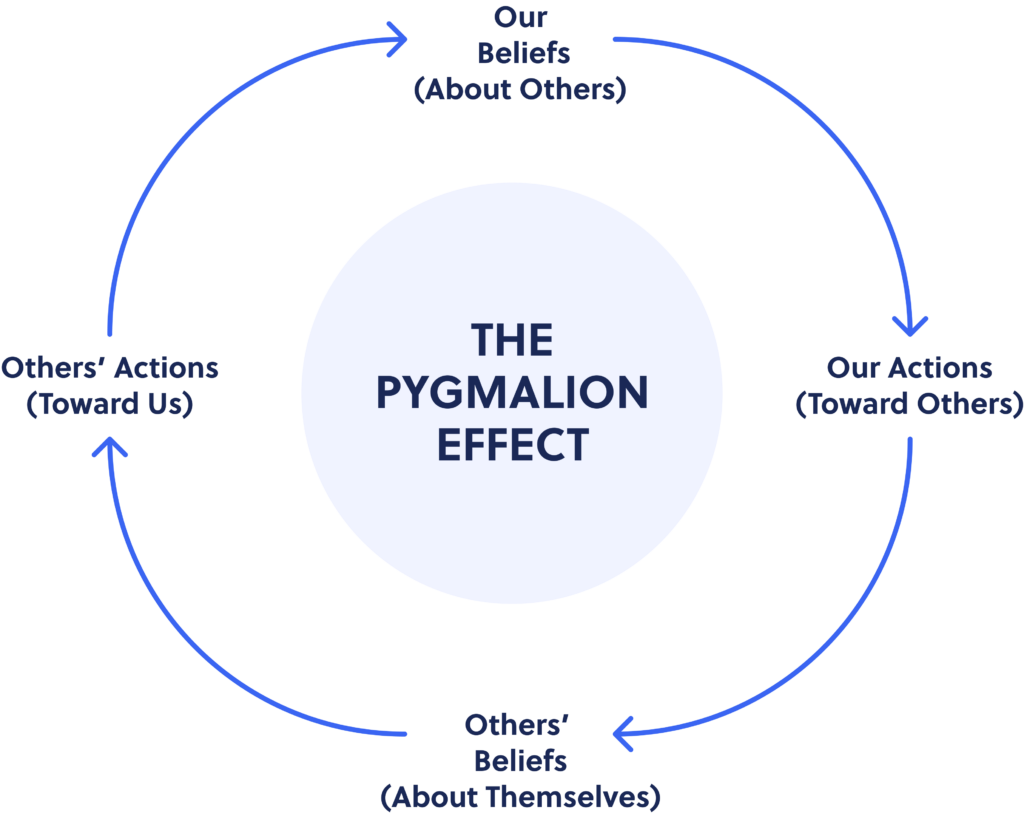Table of Contents
What is the Pygmalion Effect?
The Pygmalion Effect is a term used to describe a phenomenon in the field of psychology which has been observed and documented for many years. Experts have identified applications of the Pygmalion effect in leadership, education, workplace, relationships, and even sports.
Before diving into the intricacies of the Pygmalion Effect, it is of crucial importance to understand it. The concept stems from the ancient Greek myth of Pygmalion, a sculptor who carved the statue of his ideal woman and eventually fell in love with it, adorning it with jewels and praying every night to the gods that she may come to life. Eventually, Venus took pity on Pygmalion and brought the statue to life, and the two proceeded to live happily ever after.
George Bernard Shaw took inspiration from the myth for his renowned play, Pygmalion (1912), telling the story of Henry Higgins, an upper-class linguist. The latter decides to turn Eliza Doolittle, a low-class flower girl, into his vision of a proper lady. The play offers a different view of the Pygmalion effect and has an ambiguous ending but clearly states an idea that would later serve as a starting point for researchers: “the difference between a lady and a flower girl is not how she behaves, but how she’s treated.”
The Rosenthal and Jacobson Experiment
The psychologists Robert Rosenthal and Lenore Jacobson applied the concept to psychology in their book Pygmalion in the Classroom, launched in 1968 and based on an experiment conducted in a Californian school in 1963. The purpose of the experiment was to determine the outcome in circumstances where teachers would treat various students differently.
Rosenthal issued a Test of General Ability and randomly chose a handful of students with high academic bloomer potential. Then, the teacher-pupil interaction was observed. Another IQ test was issued to determine how IQ improved in those labeled as intellectual bloomers compared to the control group.
The experiment found that, especially in younger children (grade 1 or grade 2), the IQ significantly increased if they carried the “academic bloomer” label. Rosenthal and Jacobson concluded that the outcome is not a consequence of intellectual ability but rather of the environment: teachers had given the supposed intellectual bloomers more support, more constructive feedback, and ultimately more kindness while paying considerably less attention to low-expectancy students.

In short, the two experts reinterpreted the Pygmalion effect myth and formulated the idea that when parents and teachers have high expectations from students, their achievements increase. Up to this day, this is the most popular Pygmalion effect example. This phenomenon is also known as a self-fulfilling prophecy (SFP), which means that when you expect someone to do well or behave in a certain way, they often end up doing or acting that way because of your influence or expectations – the vice-versa being equally valid.
The Power of the Pygmalion Effect
We have already established that the Pygmalion effect is a phenomenon in which the expectations of others can influence the performance of a person or group, regardless of their pre-existing ability. In short, if you believe that someone is talented or intelligent, they’ll usually act as such. This also applies to expectations about personality traits and behaviors. When an individual is expected to act a certain way, they’re more likely to act that way.
The Pygmalion effect has been studied for decades by psychologists, and many different factors have been found to contribute to it: the expectations of teachers, peers, and even family members can all change how people perform in their jobs and relationships.
Rosenthal identified four key factors that amplify the Pygmalion effect: the climate, the input, the output, and the feedback. For example, students who benefit from a nurturing environment and receive involvement from figures of authority will ultimately develop the self-confidence needed to ace their academic goals and later become well-rounded adults.
It’s important to remember that while the Pygmalion effect can be positive—for instance, when it motivates people to work harder—it can also be harmful. Keep in mind that another Pygmalion effect example is when teachers set low expectations for students’ success and make them more likely to fail.
Examples of the Pygmalion Effect
Pygmalion Effect in Leadership
As mentioned above, the Pygmalion Effect can also be observed in leadership. Perhaps one of the most relevant cases recorded is the example of Alfred Oberlander, the manager of the Rockway district office of the Metropolitan Life Insurance Company.
In 1961, Oberlander conducted an organizational experiment by grouping agents in the following manner: the best six agents with the highest performing assistant manager, the average agents with an average assistant manager, and the low-performing agents with an equally low-performing manager.

The high-performance group improved the overall agency performance by 40% and proved that capable employees could surpass their typical productivity abilities when paired with competent leaders. He continued to apply the concept by pairing new agents with qualified managers.
He also pointed out that low-performance units that were not even given a chance to reach the established half-million-dollar mark declined even more in performance.
Oberlander identified an anomaly that goes on to prove the relevance of the Pygmalion effect in leadership: the average unit’s manager refused to accept that she was less competent than the super staff’s manager and positively influenced the agents in her group. She invested efforts into motivating her agents and ultimately achieved a productivity increase higher than the super staff, according to Harvard Business Review.
Pygmalion Effect in Workplace
Imagine you’re a manager overseeing some new hires. You have one employee who struggles with basic tasks, but you’re confident that he has good potential and is capable of doing much better with some training. Your other employee is more skilled but tends to slack off and isn’t particularly interested in going above and beyond. Chances are that, after giving both employees ample training, you’ll start to see a more significant change in your more talented employee because his potential encourages you to hold him to higher standards.
Further confirmation stems from a study conducted by David E. Berlew and Douglas T. Hall of the Massachusetts Institute of Technology, who examined 49 college graduates who were management-level employees of an operating company of AT&T. The study came to the conclusion that their success and performance were directly impacted by the company’s expectations. Moreover, the researchers discovered that the first year within the company affects long-term performance the most.
Pygmalion Effect in Education
Apart from the experiment conducted by Rosenthal and Jacobson, there are other studies that showcase the relevancy of the Pygmalion effect in education. Major Wilburn Schrank did a similar experiment in 1968 and came to the same conclusion: students considered and treated as academic bloomers eventually become it.
Jere E. Brophy, on the other hand, decided to focus on the negative expectations implied by the Pygmalion effect. His experiment demonstrated that expectation-mediated discrimination, negative expectations and false evaluation have the potential to negatively impact student motivation.
He listed eight forms of negative expectations that bred improper learning conditions: giving up easily on low-expectations students, praising them less often for their successes, criticizing them more often for their failures, praising them inappropriately, not providing any feedback, seating them in the back of the room, interacting less and paying less attention.
There is another view to consider when it comes to the Pygmalion effect in education: the students who come from the most challenging, adverse situations often go on to achieve the most success. They are resilient, resourceful, and driven by a desire for approval. This is a good thing; after all, we want our students to be successful in school, we want them to have a positive outlook on life, and we want all of them to have strong relationships with their teachers and parents.
But it’s important to realize that these students often face the highest levels of pressure and stress because they are expected to succeed—even when they aren’t given the resources they need to be successful. This expectation can put them at a disadvantage when it comes to dealing with challenges that arise outside of school.
At the same time, students who have been labeled as “problem children” or “bad students” by their teachers or parents often develop into the exact type of person that has been expected of them. This can be highly damaging to a student’s self-esteem and mental health, especially if they are constantly being compared to more successful students.
Pygmalion Effect in Relationships
The Pygmalion Effect is found in various types of social relationships like friendships, romantic relationships, mentors and mentees, teachers, and students, among others. The Pygmalion Effect can also occur in non-social contexts as well. For example, it can happen between a landlord and his tenant or even between an employee and his boss or employer.
Regarding couples’ relationships, for example, expectations are double-edged swords. While believing in your partner, supporting them in reaching their goals, and reminding them about their qualities can generate the positive effects of the Pygmalion effect, other expectations can turn out to be detrimental to the relationship.
For example, a study conducted by Carnegie Mellon University psychologists found that people in supportive marriages were more inclined to take on challenges. At the same time, individuals in less supportive marriages showcased a lack of confidence and reluctance to potentially rewarding experiences. Although the study did not focus on the Pygmalion effect, it attests to the idea that positive expectations and standards can serve as strong motivators.
Pygmalion Effect in Sport
The “self-fulfilling prophecy” and the “Pygmalion effect” have inspired studies on expectations, influences on performance in competitive sports, and those related to coaches’ expectations.
Similarly to teachers in academic environments, sports coaches form expectations based on an athlete’s physical appearance, personality, or information concerning past achievements or behavior during training sessions or skill test scores. Furthermore, expectations can be set depending on race, socioeconomic status, height, and weight-related stereotypes.
A 2013 study conducted by Małgorzata Siekanska, Jan Blecharz, and Agnieszka Wojtowicz investigated how active and former athletes perform based on perceived coach behavior.
The results identified controversial areas in the current understanding of the Pygmalion effect, suggesting that high-expectancy athletes may consider coaching behavior as inhibiting instead of enhancing. Behaviors associated with leniency and favoring can function as developmental inhibitors.
At the same time, low-expectancy athletes do tend to face more challenges, as they do not benefit from the same amount of instructions, feedback, and attention from their coaches. Additional research at a larger scale must be conducted before coming to a conclusion in regards to the Pygmalion effect and its impact on athlete performance.
The Pygmalion Effect – Pros and Cons
We have established that the Pygmalion effect is a phenomenon that occurs when the expectations of others influence people’s self-perceptions. Just like in George Bernard Shaw’s famous play, in which a professor makes a bet that he could make Eliza Doolittle, a poor flower girl, pass for a duchess at an aristocratic party, people can be influenced to improve themselves if equipped with the suitable resources.
The positive version of the Pygmalion effect is called the “Pygmalion rise” and happens when you expect someone to succeed based on your judgment of their abilities, and they do. It can be applied to professional settings, where managers can expect employees with certain characteristics to do well in their jobs and then give them opportunities relevant to those skills, which in turn help them grow into the potential they demonstrated was there. On the other hand, the negative version is called the “Pygmalion fall.” This happens when people face negative expectations and internalize them to a point where they become their reality. The Pygmalion fall is also known as the Golem effect.
Furthermore, another potentially negative aspect is associated with the Pygmalion effect: people of authority and influence who set expectations may inadvertently create an environment where people are afraid to fail because they don’t want to disappoint them. While high expectations can be motivating and encouraging, they may be perceived as extreme pressure and can lead to anxiety, low self-esteem, and avoidance.
The Bottom Line
In a nutshell, the Pygmalion Effect is a phenomenon in which we tend to treat others according to how we think about them or perceive them. Some experts qualify it as a self-fulfilling prophecy. If you see someone as intelligent and competent, that person has a great chance of being perceived by others as such and behaving according to your expectations. On the contrary – poor attitude and behavior may contribute to an undesired perception from others, which might negatively affect their performance.
We hope that this has been an insightful journey into the depths of the Pygmalion Effect. This article aims to provide a comprehensive yet easy-to-understand look at how and why this theory can be so practical. For some people, it is about identifying unconscious patterns of thought; for others, it is about self-fulfilling prophecies; and for others still, it is about setting your standards high. Regardless of how each individual relates to the concept, the Pygmalion effect spans each area of life and has the power to impact our relationships with those around us and ourselves.







